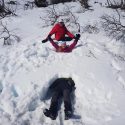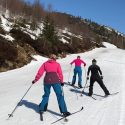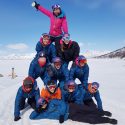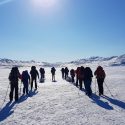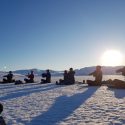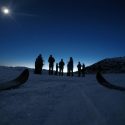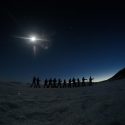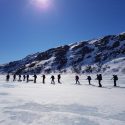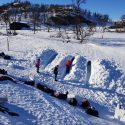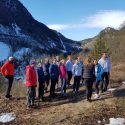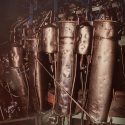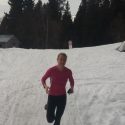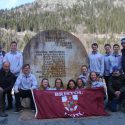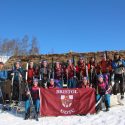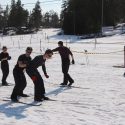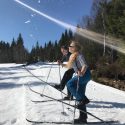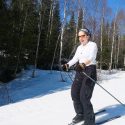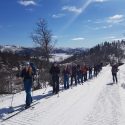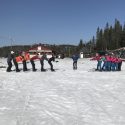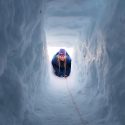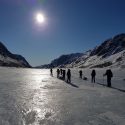On the 5th April 2019, Bristol University Officers Corps started Exercise CABOT TELEMARK 2019. An Adventurous Training exercise to Norway to gain Nordic Skiing qualifications and develop future Nordic ski leaders and instructors. 11 Officer Cadets and a WO2 Company Sergeant Major together with two Nordic Leaders took part completing the two weeks of training. The aims of the exercise were to undertake a Battlefield study on the ‘Real Heroes of Telemark’ whilst simultaneously working towards the Nordic Foundation 1 (NF1) and Nordic Foundation 2 (NF2) Joint Services Qualifications. The Battlefield study element involved the ‘immersion’ of the Officer Cadets into the challenging environment and situations experienced by both British and Norwegian soldiers of the WWII Operations GROUSE and GUNNERSIDE. These Operations took place across the Southern Uplands of the Hardanger Vidda. In the process, all participants enhanced their teamworking and leadership skills whilst working in the arduous and unfamiliar snow-covered environment.
There were four phases to the exercise: the outbound and inbound travel, a five-day basic Nordic ski training package, five days learning Nordic Ski touring on the Hardanger Vidda, and finally, a Battlefield Study at and in the area of, the Vemork Norsk Hydro Electric Plant near Rjukan. Commencing the exercise at 0300hrs followed by an 18-hour journey from Bristol to Troll Aktiv, Evje we all took the opportunity to rest and prepare for the rigours ahead. The first five days of initial skills training saw us visit the local areas of Høgås and Bortelid. Unfortunately, no new snow had fallen with cold nights and warm day time temperatures meant for a lack of snow-cover with an icy surface in the mornings. Despite the difficulties we learnt the basic techniques of Nordic skiing and were introduced to ski touring. Over the five days, we gradually gained in proficiency at the same time increasing the difficulty by lengthening the tours and increasing the weight in our rucksacks. All with a view towards practising for the challenge of the following week and second phase: touring over the Hardanger Vidda. Along with the skiing, we also covered many vital skills from the use of skins and waxing, to digging emergency shelters and understanding the weather and how to carry out risk assessments. As we were using locally bought rations during this first phase, we were responsible for our own cooking together with the appropriate budgeting and shopping. An ideal chance to hold a ‘come dine with me’ competition; some teams were better than others with some really good creations together with presentations to swing the judge’s opinion. These early evenings also consisted of lectures ranging from avalanche safety, snow shelters, rucksack packing and route planning. We also watched the fascinating Ray Mears’ documentary, ‘The Real Heroes of Telemark’, which illustrated to us the Hardanger Vidda’s terrain and demonstrated the courage shown by the Norwegian saboteurs which was really inspirational to the whole group.
The five-day NF2 phase began with a three-hour coach journey and an exhilarating ski-doo ride to the start point on the vast frozen lake, Sognavatnet. We then did a short ski to our first accommodation, Berunuten Hut, which really highlighted to us the difference that a heavier rucksack made to skiing technique. At the hut we set about getting water from the lake that we could use for cooking. We then had a lesson on how to use our GPS, followed by a night ski on the lake after the sun had set. On the second day, we set off for a practice with the pulks, one pulk per six people. Pulk changes soon become slick and efficient and we developed our downhill skiing techniques as well. That evening we had a yoga session on the ice-covered lake, not everyone could fully match the positions, but we did ease the day’s aches and pains though. On the third day we set off on the longest leg of 20km, starting first with the length of the Songavatnet lake, crossing into the Valasjadalen valley. This day was great NF2 training, across demanding and undulating terrain. We split into two huts that evening, with one group staying in one of the original huts that the Norwegian Saboteurs had stayed in.
Day four started off by crossing Lake Bitdalsvatn. Following this we covered some undulating and technical ground, where teamwork was vital for hauling the pulk both up and down some steep slopes. After several hours we arrived at Reinar Hytte. While we had a quick brew and some soup, Major James, our Senior Instructor/Leader, went to find a suitable snow-hole location. After, what seemed an age, he returned with the good news. He had found a low snow bank that had just enough depth to dig three snow-holes side by side. We were straight out and set off to dig our night’s accommodation. Some six hours later and after a lot of hard work we were given the approval to spend the night out. A quick warm sitting around a fire and toasting marshmallows then into all the warm kit and sleeping bags that we had. Unfortunately, we could not construct the ideal ‘cold trench’ due to the snow depth this meant for a cold and not too comfortable night’s sleep. That said, it was a great experience. An early start after a team photo and we set off for our final day of the NF2 phase. Upon completion of this phase, we picked up our minibus and drove to the mountain lodge of Kvitavatn high above the Rjukan valley. The ‘luxury’ of a hot shower, plenty of food – cooked by someone else and even a sauna was fully appreciated by all. The intentions for the following day were to carry out the historic battlefield re-enactment into the gorge above the Power Plant but the conditions were to affect us yet again.
Unfortunately, due to a lack of snow, we were unable to follow the exact footsteps of the saboteurs during their attack route on the Vemork Power Plant. However, we spent some time in the local area understanding the difficulties of the terrain together with appreciating the museum where we gained more knowledge on the significance of the saboteurs’ actions. After we left the museum, we proceeded to the base of a steep path that the saboteurs used as their escape route where we found our final challenge was to be. 21 bends, 3.8kms and 500m of climb of the saboteur’s escape route under the Krossobanen Cable Car. Our very own OCdt Annie Evans completed it in a time of 29 minutes, earning her the title of fastest ever female. We all gained a real insight into what the saboteurs experienced via challenging ourselves to get the best time up the route that the they took as they escaped the valley, literally under the noses of the German controlled Cable Car.
The whole exercise experience made it apparent, to us all, that we should all try to emulate the characteristics of determination, courage and resilience displayed by the saboteurs, in our day to day lives and as a modern military. A comment that pulls together our feelings about the exercise:
“For me personally Ex CABOT TELEMARK gave me an incredible opportunity to learn how to Nordic ski, completing the NF1 phase and then improving and developing this learning in the NF2 phase. The challenges we faced, including skiing across near sheet ice for 6km, made me appreciate the importance of having strength throughout the team both mentally and physically. I learnt important lessons in resilience, determination and camaraderie which I am sure I will be able to use within my everyday life.”
We have learnt so much in the two weeks, a lot about the environment, about ourselves and about this unbelievable story. It has been an unforgettable experience and we all have lots of stories to share.

